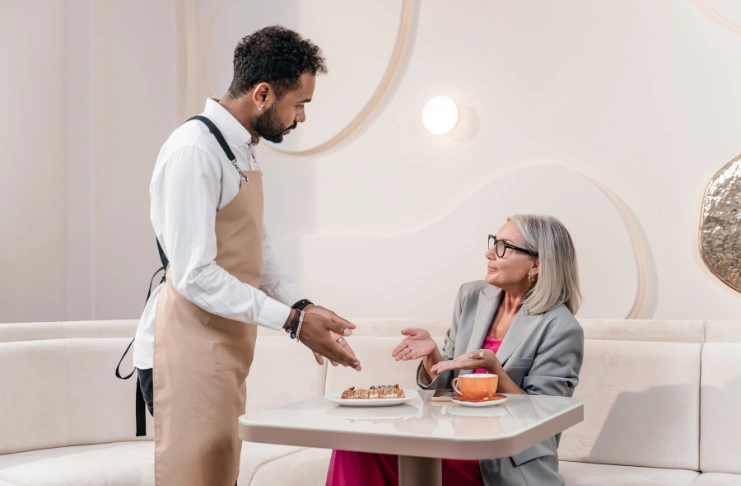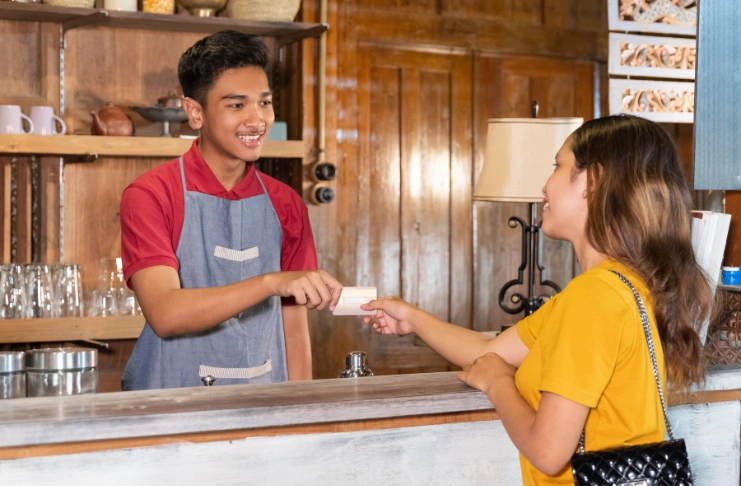Great food brings guests in. How you manage them determines if they return.
Customer management in restaurants is no longer just about polite service. It aims to make every interaction seamless, responsive, and profitable. From handling wait times to resolving complaints, what happens beyond the plate directly impacts retention, reputation, and revenue.
This guide lists some of the most practical strategies for optimizing guest interactions and delivering exceptional service.
Understanding the Restaurant Customer Journey

Every guest interaction is an opportunity to strengthen your brand. From the moment a reservation is made to the final payment, each touchpoint shapes how guests perceive your service and ultimately determines whether they return.
It starts with first impressions. A warm welcome within 30 seconds of arrival, even during peak hours, sets the tone for the entire experience. A genuine greeting not only makes guests feel seen but also signals a culture of attentiveness.
Beyond the entrance, table management plays a critical role. The way you seat guests directly affects the rhythm of your service. Smart seating ensures your servers aren’t stretched thin, which improves responsiveness and creates a more relaxed, enjoyable dining atmosphere.
Mastering Customer Expectations

Understanding what guests expect is the foundation for consistently exceeding those expectations.
One of the most important skills in this regard is deep menu knowledge. Servers should be able to answer questions about ingredients, preparation methods, and potential allergens without hesitation. This builds trust and shows professionalism.
Equally important is the ability to read guest behavior. A rushed guest and a couple celebrating an anniversary expect very different things. Skilled staff can pick up on subtle cues (body language, tone, pace) and adjust their service accordingly. This kind of attentiveness turns routine meals into personalized dining experiences.
INDUSTRY INSIGHT
| Studies found that restaurants that successfully resolve complaints see a 70% increase in customer retention compared to those that handle complaints poorly. More significantly, guests who experience excellent service recovery often become more loyal than those who have never encountered a problem, demonstrating the importance of effective customer management. |
Handling Customer Complaints Effectively

When service or food falls short of expectations, how your team responds can transform a potential negative review into a showcase of your commitment to guest satisfaction.
Listen Attentively Without Interruption
When facing an angry customer, your first response should be to listen completely. Allow the person to express their concerns without interruption, showing that you value their feedback and take their complaints seriously.
Express Sympathy and Ownership
Acknowledge the guest’s feelings with phrases like “I understand why that would be frustrating” or “I’m sorry your meal didn’t meet your expectations.” Taking ownership of the situation, even if you weren’t personally responsible, demonstrates accountability.
Offer Clear Solutions
After understanding the complaint, present specific solutions rather than vague promises. Depending on the situation, this might include:
- Remaking the dish
- Offering a complimentary dessert or drink
- Removing the item from the bill
- Providing a gift certificate for a future visit
The best solution addresses both the immediate concern and ensures future visits will meet expectations.
Training Your Team for Excellence

A restaurant’s service is only as strong as its least-trained team member. Strategic training transforms average employees into customer service champions.
Role-Playing Difficult Scenarios
Practice makes perfect when dealing with challenging situations. Regular role-playing exercises prepare staff to handle everything from minor complaints to genuinely irate customers while maintaining clear boundaries and professionalism.
Creating Service Standards
Establish specific, measurable service standards for each position. For example:
- Guests greeted within 30 seconds
- Drink order taken within 3 minutes of seating
- Food quality checked within 2 minutes of service
These standards provide a framework that enables consistent service delivery across your operation.
Building Customer Loyalty Programs

Repeat business forms the backbone of restaurant success. Strategic loyalty initiatives encourage guests to return while providing valuable data about customer preferences.
Consider:
- Early access to new menu items
- Personalized experiences based on past orders
- Special event invitations
- Recognition from staff for regular customers
These approaches create emotional connections that transcend typical discount-driven programs.
Technology for Better Customer Management in Restaurants

Modern restaurant technology enables more personalized service while streamlining operations. Customer Relationship Management (CRM) systems built specifically for restaurants can track guest preferences, special occasions, and past feedback, giving your team the data they need to anticipate needs and deliver tailored experiences.
Feedback platforms are equally critical. Use them strategically by:
- Monitoring reviews across all major platforms
- Responding professionally to both positive and negative comments
- Identifying recurring trends that require operational changes
- Sharing positive guest feedback internally to boost team morale and reinforce service standards
De-escalation Techniques for Tense Situations

Even the best restaurants occasionally face challenging guest interactions. Proper de-escalation techniques protect both the guest experience and team well-being.
Stay Calm and Maintain Perspective
When facing an irate customer, your emotional control sets the tone. Speaking calmly and maintaining professional composure prevents escalations and demonstrates confidence in finding solutions.
Move Conversations to Private Spaces
When guests become visibly upset, politely invite them to a quieter area away from other diners. This serves multiple purposes:
- Protects the dining experience of other guests
- Gives the upset person space to express concerns without an audience
- Demonstrates respect for their privacy
- Creates an environment more conducive to resolution
Empowering Staff to Solve Problems

Restaurants that enable employees to resolve issues without constant managerial approval create more satisfying guest interactions. So, what should you do?
Define what solutions staff can offer without manager involvement. For example, servers might be authorized to:
- Comp beverages up to a certain value
- Offer replacement dishes without question
- Provide gift certificates within specific limits
This autonomy speeds resolution and makes guests feel their concerns matter.
Turning Service Excellence into Business Growth

Exceptional customer management directly impacts financial performance through improved retention, higher average checks, and more tips for staff.
Track these restaurant KPIs to quantify your service improvements:
- Return visit frequency
- Average check size
- Online review sentiment
- Staff retention rates (happy employees create happy guests)
These measurements create a clear connection between service quality and business success.
Conclusion
Customer management in restaurants directly drives guest loyalty and operational success. With the right systems, training, and responsiveness, every interaction becomes a chance to strengthen your brand and grow your bottom line.
Frequently Asked Questions
1. What is CRM in restaurants?
CRM (Customer Relationship Management) in restaurants refers to systems and practices that track guest preferences, visit history, and feedback to create personalized experiences and build loyalty.
2. How to handle a customer in a restaurant?
Handle restaurant customers with genuine warmth, attentive service, thorough menu knowledge, and quick response to requests. Anticipate needs before they arise and create memorable moments throughout their dining experience.
3. What is service management in a restaurant?
Service management in restaurants involves creating systems, standards, and training programs that ensure consistent, high-quality guest experiences across all touchpoints—from reservation to payment and follow-up.
4. What customer management means?
Customer management means systematically managing guest relationships throughout their journey with your business. This includes anticipating needs, resolving complaints, gathering feedback, and creating personalized experiences that build loyalty.
5. How to deal with rude customers in a restaurant?
Deal with rude customers by staying calm, listening completely without interruption, acknowledging their concerns, offering practical solutions, and maintaining professional boundaries. Never respond rudely or defensively.
6. How to tell a customer to stop being rude?
Politely address rude behavior by saying, “I want to help solve this issue, but I’ll need you to speak with me respectfully so we can find the best solution together.” Maintain a calm tone and focus on the specific behavior rather than labeling the person.
7. How do you handle an angry customer?
Handle angry customers by listening attentively, expressing genuine sympathy, avoiding defensiveness, offering specific solutions, following up to ensure satisfaction, and documenting the interaction for service improvement.
8. How to handle a difficult customer in a restaurant?
Handle difficult restaurant customers by staying composed, listening completely to their concerns, acknowledging their perspective, offering viable solutions, involving management when necessary, and ensuring the rest of their experience is exceptional.
9. What is an example of how you dealt with a difficult customer?
An example of successfully handling a difficult customer: When a guest complained their steak was overcooked, [staff] listened without interruption, sincerely apologized, immediately arranged for a properly cooked replacement, comped their drink while waiting, and checked back personally to ensure satisfaction. The guest left a positive review.
10. How to politely tell a customer they are rude?
Politely address rudeness by saying, “I’m committed to finding a solution, but I’d appreciate it if we could discuss this calmly so I can better understand and address your concerns.” Focus on the behavior’s impact rather than labeling the person.
11. What are the rules for dealing with difficult customers?
Rules for dealing with difficult customers include never taking it personally, listening completely before responding, acknowledging their feelings, offering specific solutions rather than excuses, documenting the interaction, and following up to ensure resolution.
12. What are the 7 skills of good customer service?
The seven customer service skills are: active listening, clear communication, empathy, product/menu knowledge, patience, problem-solving ability, and positive language. These skills enable staff to create exceptional experiences even in challenging situations.





